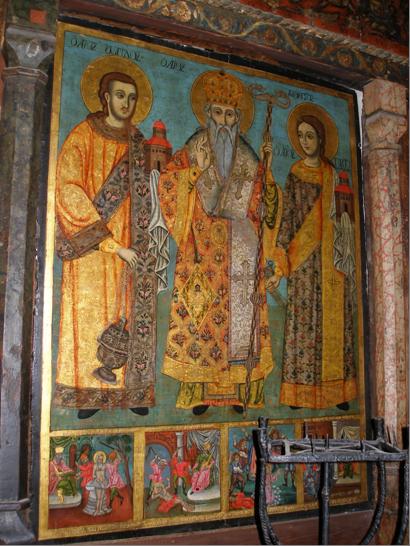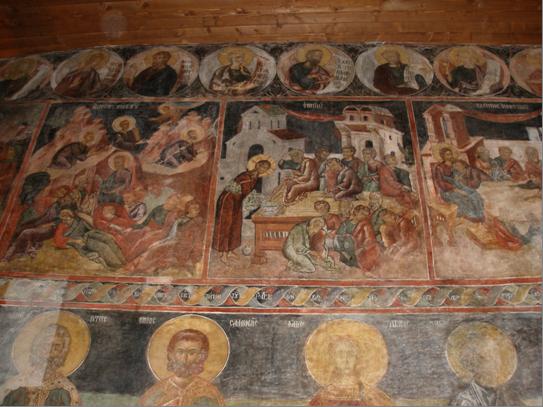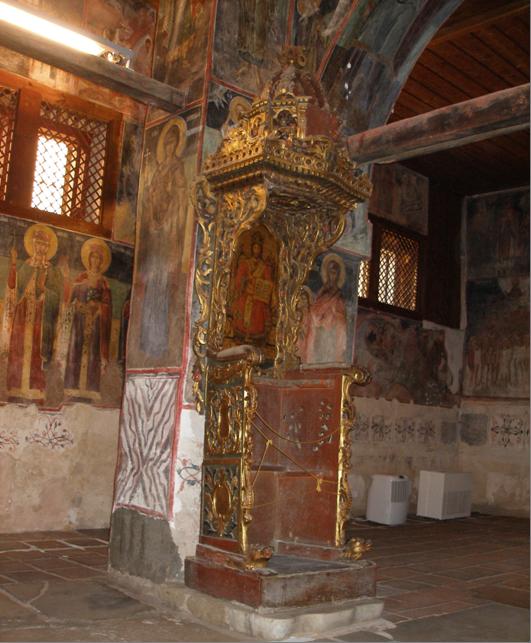
Reserved Area
Artists - ArtWorks
Saint Stephan Church in Nessebar
 Bulgaria
BulgariaTraditional religious painting with attempts for realism
The “Saint Stephan” church in Nessebar /the new bishop’s residence/. The church has initially been devoted to Mother Mary and only later through the centuries it has been renamed after Saint Stephan. According to specialists the church has been painted and ornamented by 3 artists, students of the Crete art-school, probably trained in Athos. According to some researchers the master among them was called Bishop Nicholaos, for whom there are no preserved biographical data.
Traditional religious painting with attempts for realism. The period of the painting is presented into a ktitor inscription above the south door of the naos - 1599. the church was dedicated to Mother Mary and all scenes in it are thematically connected to the mother of God, despite the fact that its patron today is St. Stephan.
Historically – the church has been built during 11 – 13 century, while in the 16 century – during the Ottoman yoke – it was reconstructed to the west, while in the 18th century a narthex was added. During its construction perches, capitals and relieves were added from Christian buildings, which had earlier been destroyed by the Turks.
Artistically – it is a typical example of the monumental-decorative Orthodox art of the 16th century, which had been ideologically and philosophically dictated by Athos. The specialists describe the murals and iconographic techniques as Crete art school.
As far as style is concerned, three masters are established – two worked in the eastern part of the naos /from the Greek “naos” meaning temple – it is a term used in sacral architecture and represents the internal part of a temple/ and in the western part. Most probably the artists were trained in the Athos monasteries, as was the custom back then. The wall paintings and ornaments of the St. Stephan church are connected with metropolitan bishop Hristophor, a trainee of the religious literary school “St. Joan Precursor”, which was active on the island bearing the same name, close to Sozopol. During the Ottoman yoke it managed to preserve for quite a while the traditions of the famous 14th century Turnovo and Kilifarska literary schools. Metropolitan bishop Hristophor was a respected cleric, today known as the Exarch of the Black Sea. This is why he managed to convince the mediaeval rich tradesmen from Nessebar to finance the reconstruction of the ancient church, known today as the new bishop’s residence. He is the man who hired the group of artists who painted the magnificent frescos in the church.
Preserved in Nessebar are more frescos by the same artists – in the churches “St. George Small” and “St. Spas” /1609/. The work of these artists follows the rules of Athos, but at the same time the murals in St. Stephan have an image of their own – they are distinctively connected with real life, which sharply distinguishes them from the Athos images. The majority of the compositions present life scenes and during their elaboration realistic motives and elements have been used.
The scenes presented on the walls are 258, while the faces – more than 1000. Almost all compositions are thematically related to the Mother of God. Here are some them – “Mother of God with Baby Christ on a throne”, the mother of God hymn “For you he rejoices...”, “Assumption”, “Introduction of Mother of God to the church”. The scenes from the cycle of miracles of Christ are presented in a whole consecution according to the gospel legends – Christ healing the physically and mentally ills, resurrects the dead, calms the storm at sea, helps the rich catch of fish, etc. The healing compositions are many, which is described with the healing qualities of the Nessebar beach. The presented murals are an example of how the Bulgarian painters managed to connect the gospel plots with the natural, historic and economic characteristics of the place they work in – they make an artistic interpretation of the canon.
Later /XVIII century/ on the eastern side of he narthex was painted the scene “Judgment day”.
The church is rich with frescos. The frescos are dated by the founder’s inscription /1599/, which is located above the entrance door. Multi-actor scenes from the series “the miracles of Christ” defend the idea that the Mother of God is an intermediary between the son of God and the human. The realism of the icon-painting masters finds expression in a part of the compositions with life scenes.
The iconostasis, dated from the XVI century, is wooden, frugally ornate with shallow engravings. This iconostasis had three lines, but only two of the registers are preserved today. The presentation of the apostles has been done according to the XVI century tradition – on a single board. The faces of the apostles, Mother Mary and John the Patist, from the central scene “Prayer” are presented under the relief arches. Christ is painted in the size of an icon. The architraves and the pedestals of the iconostasis are ornate in the characteristic oriental style “Tulip”. The bishop’s throne and the pulpit /XVIII century/ are interesting with the shallow engravings of large floral motives as well as with the oval painted fields – gold-plated and poly-chromed.
Transnational comparisons can be found between the murals in St. Stephan and images of the same period, preserved in the monasteries of Athos – created by painters from the Crete art schools, which due to historical reasons /Crete remained outside of the Ottoman invasion/ had preserved the traditions of Orthodox iconography.
The frescos from the Nessebar churches “St. George Small” /destroyed in 1946/ and “St. Spas”, which at present is a museum are dated from the ten years to follow St. Stephans chronology – 1609.
Realism elements, which are early for this period in Bulgaria. Freedom of ornamenting /oriental elements/. The site is a UNESCO heritage monument. The church “St. Stephan” is one of the rarest monuments in our country with well preserved murals from the ХVІ-ХVІІІ century. Thanks to its preserved architectural image, its iconostasis and mainly its remarkable murals the “St. Stephan” church is one of the most important monuments of Bulgarian cultural heritage.
Nessebar. Sofia, Art tomorrow.
Velkov, Velizar Ivanov. Nessebar : [feature article]. - Sofia : Borina, 1995.
http://www.pravoslavieto.com/hramove/nesebar/sv_Stefan/index.htm
http://www.ancient-nessebar.com/site/?cat=4&sub_cat=2&ss_cat=4
Related Material:
Image available

File name: 18_XVI 1.JPG
Description of the material:
The ktitor portrait at the church – presenting the investors with small model churches in their hands and the bishop between them.
Contextualisation Of the source:
The photo has been taken by the team managing http://www.nessebar-news.com/news/ - one of the best portals on the city of Nessebar.
Interpretation of the source:
One of the well preserved murals in the church – rich in color and ornaments.

File name: 18_XVI 2.JPG
Description of the material:
Images of the miracles of Christ.
Contextualisation Of the source:
The photo has been taken by the team managing http://www.nessebar-news.com/news/ - one of the best portals on the city of Nessebar.
Interpretation of the source:
One of the well preserved murals in the church – rich in color and ornaments.

File name: 18_XVI 3.JPG
Description of the material:
The bishop’s throne.
Contextualisation Of the source:
The photo has been taken by the team managing http://www.nessebar-news.com/news/ - one of the best portals on the city of Nessebar.
Interpretation of the source:
The bishop’s throne is interesting with the shallow engravings of large floral motives as well as with the oval painted fields – gold-plated and poly-chromed.
Comments about this Artist/ArtWork
Michelangelo - Copyright 2008 - This project has been funded with support from the European Commission